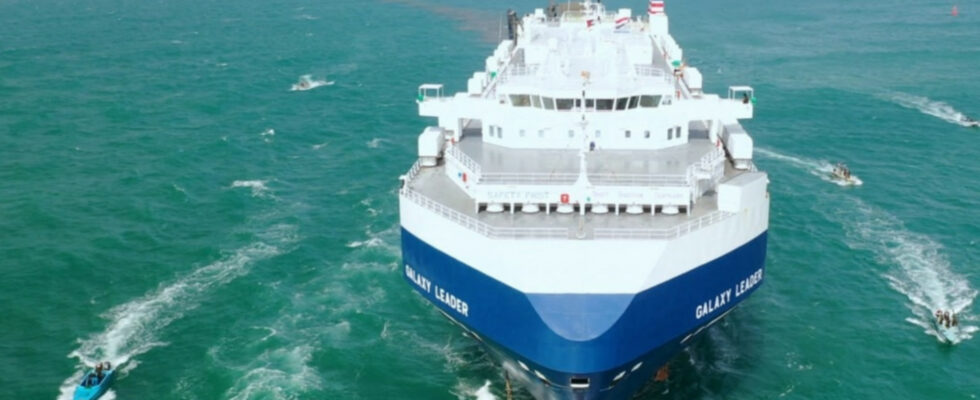Romain Rouillard / Photo credit: HOUTHIS MEDIA CENTER / HANDOUT / ANADOLU / ANADOLU VIA AFP
This is collateral damage from the conflict between Israel and the Hamas terrorist movement. For several weeks, navigation in the Red Sea has been made impossible by incessant attacks by the Houthis against commercial ships, accused of maintaining links with the Jewish state. The Yemeni rebel movement, an ally of Iran, targets all boats crossing the Bal al-Mandeb Strait, which separates Yemen from the Horn of Africa. A few weeks ago, a dramatic video showed gunmen descending from a helicopter onto a boat, owned by an Israeli businessman, and forcing the crew to surrender. Faced with the risks involved, several shipowners, including the French CMA-CGM, have announced that their ships will henceforth avoid the area. The British hydrocarbon giant BP also announced that it was suspending all transit in the Red Sea.
#Yemen here is how the Houthis with the means of the Yemeni state committed an act of maritime piracy in the Red Sea on 19.11 against the cargo ship owned by an Israeli businessman. This is as part of their support for #Hamas#Gazapic.twitter.com/x0uvNpfz77
— Wassim Nasr (@SimNasr) November 20, 2023
“Ten more days at sea”
This Tuesday, the United States, through Defense Minister Lloyd Austin, announced the formation of a coalition of ten countries supposed to ward off the threat of the Houthis on this very busy maritime route. For their part, the Yemeni rebels responded by assuring that the attacks will continue “whatever the sacrifices it costs us”.
After several weeks of blockage, the economic repercussions are already numerous. Ships have no other choice than to take a long detour to connect Asia to Europe, where the passage of the Red Sea and then the Suez Canal saves time (and money). ) considerable. “The circumnavigation of Africa, via the Cape of Good Hope, is ten days more at sea. It is therefore an additional cost for shipowners who will pass it on,” predicts Pierre Cariou, professor at Kedge Business School and specialist in maritime transport economics. These ships will, at the same time, save on the right of passage on the Suez Canal, estimated at $600,000 for each crossing. “But the boats will be used longer, so this will eat into these savings. Not to mention the increase in fuel costs,” adds the expert. In total, the increase in transport costs would be between 10 and 20%.
Towards a rise in oil prices?
Oil prices could also rise significantly if the blockage continues. Because in addition to commercial ships, many oil tankers use this sea route daily. The price of a barrel of Brent was also revised upwards this Tuesday evening, given the stubbornness of the Houthis in continuing their operations. Oil shipments through the Bab Al-Mandeb Strait accounted for about 12% of the world’s total seaborne oil in the first half of 2023, according to a note from S&P Global Commodity Insights.
Added to this is also the disorganization of logistics chains which risks generating significant additional costs, but also delivery delays. “These ships which have to pass through South Africa, for example, will instead go to the ports of northern Europe. And then, it is a question of knowing how to get these container ships back to Italy or Greece. Delivery time will increase and, for importers, the cost of immobilizing stock will be greater,” raises Pierre Carou. The risk of shortage is, however, ruled out by specialists. “There is no cutoff. We just take the longest route. Between 1967 and 1975, the Suez Canal was closed and ships were going around Africa. It’s doable, but it requires more of boats, we tire the crews and this has an economic cost”, summarizes Paul Tourret, director of the Higher Institute of Maritime Economics.
“A lot of goods are already there”
In addition, such a blockage at this time of year is less harmful for the global economy. “It’s a few days before Christmas, which means a lot of goods, the toys in particular are already there. We were already supplied two months ago, at the time of peak demand,” explains Pierre Cariou. Generally speaking, due to the gloomy global economic context, demand in Europe is not experiencing any spectacular surges in recent years. recent months, recalls Paul Tourret.
However, the multiplication of obstacles to navigation plunges importers and exporters into uncertainty regarding traditional navigation patterns. “There had already been the blockage of the Ever Given a year and a half ago (a container ship which got stuck diagonally in the Suez Canal Editor’s note), the passage of the Panama Canal is becoming more and more more difficult because of the drought. All this reinforces what we have seen emerging since the pandemic, that is to say the vulnerability of our logistics chains and these major journeys. So for shipowners, this is not not good news because importers and exporters will inevitably end up calling these plans into question. Every two or three months, there is a new event,” concludes Pierre Cariou.
